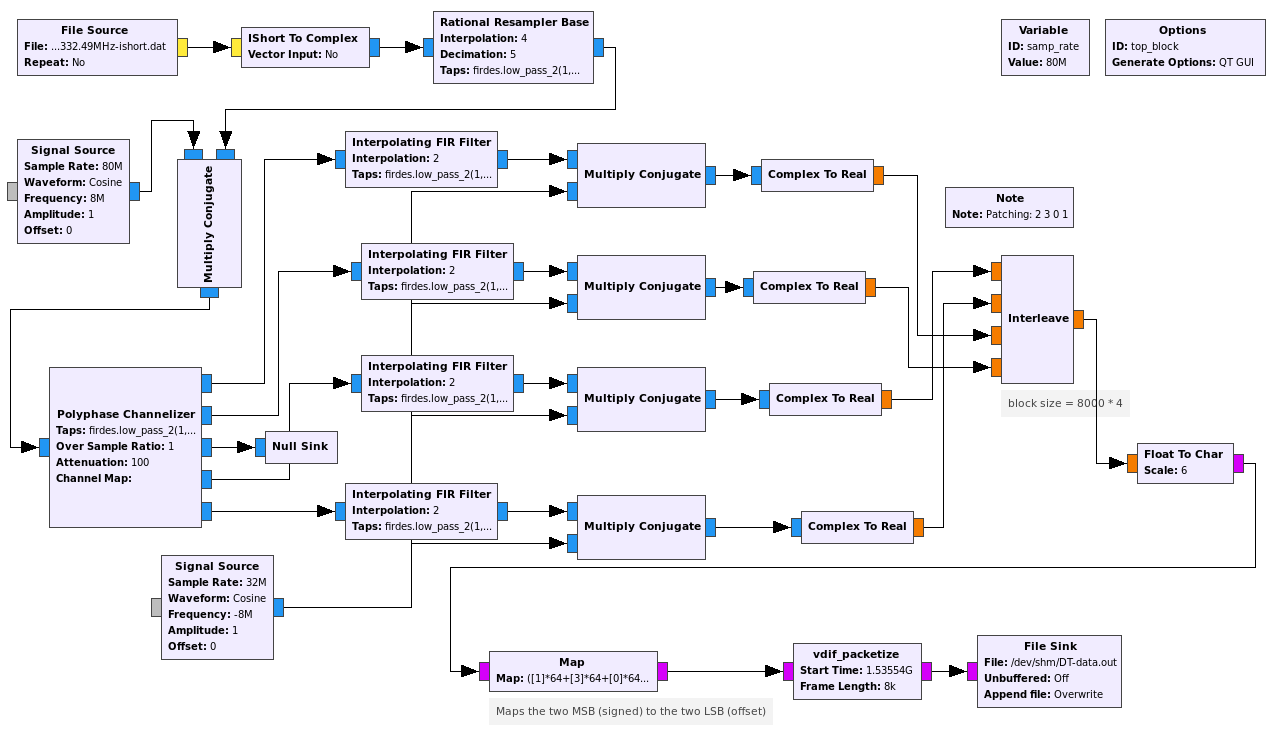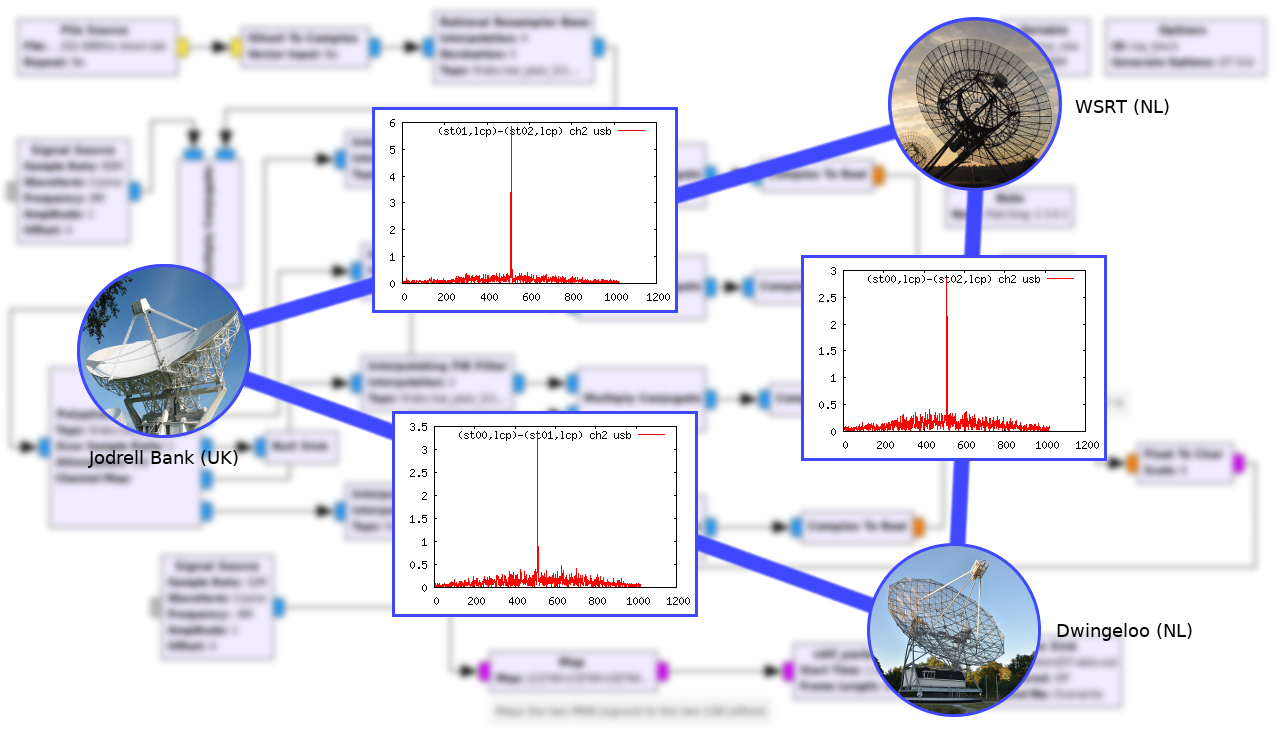A gnuradio block to add VDIF (and VTP) headers to a stream of samples.
What is VDIF? What is VLBI?
VLBI stands for Very Long Baseline Interferometry, a technique in radio astronomy where a source is observed by a geographically distributed array of radio telescopes. These telescopes form a radio interferometer, and its resolution is determined by the largest distance between participating telescopes and the observing wavelength. In VLBI, participating dishes can be separated by continental distances, and longer when space based radio telescopes contribute as well.
VDIF is the VLBI Data Interchange Format, a standard that describes how to format and store the timestamps and digitized radio spectrum. Having such a standard makes it much easier to exchange recordings. The VDIF standard is available at https://vlbi.org/vlbi-standards/vdif/
Gr-vdif is a GNU Radio out-of-tree module that can be used to apply VDIF headers to a VLBI recording. It allows one to use a COTS (commercial off the self) SDR (software defined radio) to digitize some portion of the radio spectrum, use the already existing DSP blocks in GNU Radio to create subbands with the correct sample rate and perform quantization (usually 2 bit), and finally the gr-vdif block to generate the required VDIF headers.
This is not intended to replace the bespoke formatters in use at regular VLBI telescopes. For the high bandwidths used in most VLBI observations, the software doesn't even come near to real time performance. It is however useful for cheaply adding limited VLBI capabilities to existing dishes, for comissioning, and to test correlator systems. Recorded SDR samples can be re-run through different configurations, permitting research on the effects of e.g. subband width, complex vs. real samples, filter taps and more.
At the moment, gr-vdif expects its data to be real (not complex), 2-bit sampled at 32 MS/s (16 MHz subbands). The data must be delivered as an interleaved stream of samples, where the interleaving should be done in blocks that equal the configured frame length. See the 'example' section for a setup that is known to work. This interface can certainly be improved upon, and is therefore subject to change.
The flowchart depicted below takes the output of one TwinRX module (80 MHz of spectrum, sampled at 100MS/s complex, stored as interleaved shorts). Out of this, four subbands of each 16 MHz wide are extracted, conveted into real (USB) samples sampled at 32MS/s. The data is then interleaved by groups of 32000 samples (corresponding to the requested framelength of 8000 bytes), before being fed into the gr-vdif OOT block. This block then adds the VDIF headers.
This particular flowchart was used to achieve VLBI fringes between the Dwingeloo, WSRT and Jodrell Bank radio telescopes, as depicted in the second image. For more details on these experiments, see the `publications' section.
- The module is written for GNU Radio 3.8.x
This software is in a very preliminary stage, and many features are missing or not yet fully implemented. Below is a list of items that are on my TODO list:
- Verify with different number of channels (4 is known to work)
- Implement VTP counter
- Allow complex data as well as real
- Make sample rate configurable (currently only 32 MS/s is supported)
- Show real-time sampler stats
- AGC, power measurements and logging for T_sys data
- Read timestamps from recorded samples
- Configure number of channels from the number of input ports
This software was written by Paul Boven boven@jive.eu
This is free sofware; you can distribute it and/or modify it under the terms of of the GNU General Public License as published by the Free Software Foundation; either version 3, or (at your option) any later version.
This software is distributed in the hope that it will be useful, but WITHOUT ANY WARRANY; without even the implied warranty of MERCHANTABILITY or FITNESS FOR A PARTICULAR PURPOSE. See the GNU General Public License for more details.
You should have received a copy of the GNU General Public License along with this software; see the file COPYING. If not, please write to the Free Software Foundation, Inc,. 51 Franklin Street, Boston, MA 02110-1301, USA.
The results from our initial VLBI tests have been published in:
- Proceedings of the 14th EVN Symposium and Users' Meeting, Granada, 2020 https://pos.sissa.it/344/156/pdf
This work would not have been possible without all the dedicated volunteers that are maintaining the Dwingeloo Radio Telescope. To learn more about our historic instrument, visit http://www.camras.nl/en .
Part of this work was funded through the ASTERICS project, a project supported by the European Commission Framework Program Horizon 2020 Research and Innovation action under grant agreement n. 653477.
My colleagues at JIVE who helped with bugfixes and testing this software, and who taught me how to process experiments on the EVN correlator at JIVE. ASTRON for their support to the project and access to the hydrogen maser and a dish at the WSRT, and Jodrell Bank Observatory for participating in some of the test observations as well.

